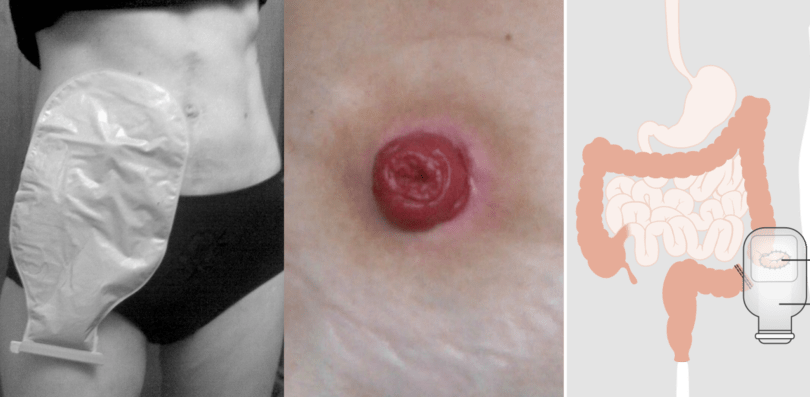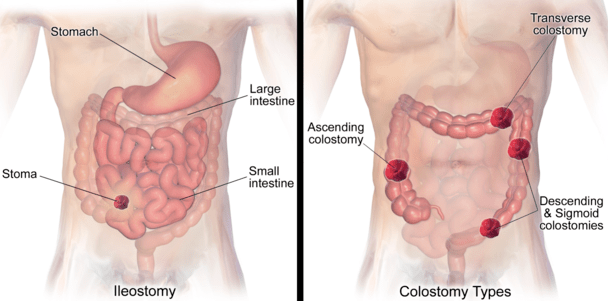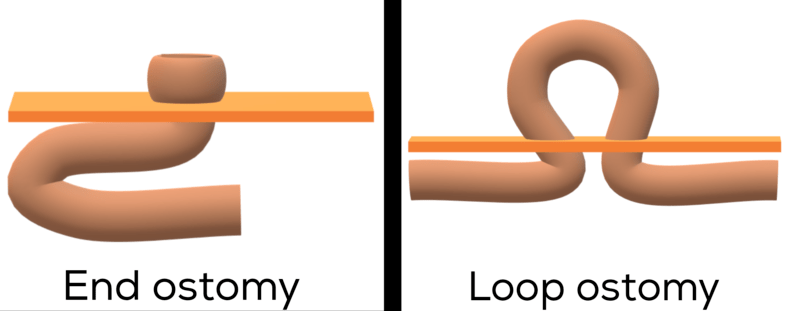Ostomy (ileostomy or colostomy)

What is an ostomy?
An ostomy is an opening in the abdominal wall, made surgically. The intestine is brought out through this opening to form a stoma. A stoma looks pink to red, is warm and moist and secretes mucus. Intestinal contents will now leave the body through the stoma and collect in a pouch.
The ostomy could be:
- Ileostomy or colostomy
- Temporary or permanent
- End or loop
Ilestomy, colostomy and urostomy
Ileostomy: In ileostomy, we bring a segment of the small intestine onto the abdominal wall through the opening. The small intestine has two parts: ileum and jejunum. Usually, the ileum is brought out.
Colostomy: Colon is the last part of the intestine, also called the large intestine. When the colon is brought out through the opening in the abdominal wall, it is called a colostomy. Depending on the segment of the colon which comes out, it could be sigmoid colostomy, descending colostomy, transverse colostomy or ascending colostomy.

Urostomy: When urine needs a diversion, a urostomy is made. The end of the ureters (a tube which drains urine from the kidneys to the bladder) is joined to a section of the small intestine. It is then fashioned into a stoma.
Ilestomy vs colostomy
The colostomy discharges thicker content than an ileostomy. The output is more in an ilestomy and requires more frequent emptying. The colostomy output is also less irritating to the skin.
Temporary and permanent ostomy
Many operations require removal of part of the intestine. Temporary ostomy is needed when the intestine needs time to heal before intestinal continuity is restored. A temporary diverting stoma is created when an intestinal joint needs time to heal. This could either be a diverting ileostomy or colostomy. A permanent ostomy is made when restoring intestinal continuity is not possible.
End vs loop ostomy
An end ileostomy or colostomy is one in which only one end of the bowel is brought to the surface of the abdomen, and the other end is closed and left inside the abdomen or sometimes brought out as mucus fistula. In loop ileostomy or colostomy, a loop of bowel is brought to the surface and an opening is made into it.

The output from the ostomy will be liquid to pasty depending upon what you eat. You cannot control the passage of stool and gas from the stoma. You will need to empty the pouch several times per day. Initially, the stoma output is high. As the body adapts to the new condition, it decreases. Most people will not notice your ostomy unless you tell them about it.
Pouching system
A pouching system is used to collect ostomy output. These are of 2 types, one-piece or two-piece system. Both include an adhesive plate that sticks to the skin around the stoma (called a faceplate, flange, skin barrier, or wafer) and a collection pouch. The skin barrier or faceplate of the pouch has a hole for the stoma. It protects the skin from the stoma output and is gentle to the skin.
In a one-piece system, the pouch and faceplate come fused. In a two-piece system, the faceplate and pouch are separate and detachable.
Pouches are clear or opaque and come in different lengths. There is a closing device at the end of the pouch called a clamp or tail clip. You can empty the pouch by opening the clamp. The design of modern pouches prevents odour. Some of them have a filter that deodorizes and vents gas.
Pouching accessories:
Ostomy belts: Worn like a belt it provides additional support to the pouching system. It attaches to the loops on the pouch and wraps around your abdomen.
Skin barrier: Liquid, wipes and powder. It helps protect the skin and aid in adhesion.
Skin barrier paste: It is used to fill the skin fold or crevices for better adhesion of faceplate to the skin.
Tapes and pouch covers:
Emptying and changing ostomy bag
Empty the pouch when it is about 1/3 full to keep it from bulging and leaking.
There may be less bowel activity at certain times of the day such as the early morning or a few hours after the meal. It is easiest to change the pouching system during these times.
The time a pouch will stay sealed to the skin depends on the weather, sweating, skin condition, scars, weight changes, diet, activity, body shape near the stoma, and the nature of the ostomy output. Usually, you need to change it every 3-5 days. If there is leakage, change it immediately.
Protecting the skin around the stoma
The skin around your stoma should look the same as skin anywhere else on your abdomen. Use the following tips to keep your skin healthy:
Use the right size pouch. Skin barrier opening should be only 1/8 inch larger than the stoma. Too small an opening can cut or injure the stoma and if it is too large, the output could get to and irritate the skin.
Change the pouching system regularly to avoid leakage and skin irritation. Itching and burning are signs that the skin and pouching system needs cleaning and change.
Remove the faceplate gently by pushing the skin away from the faceplate rather than pulling it away from the skin. Do not change it too frequently.
Clean the skin around the stoma with water and mild soap. Dry the skin completely before putting on the skin barrier.
Watch for sensitivities and allergies. Test products to see how your skin reacts to them.
Eating and digestion
You can eat whatever you want. Various foods affect your digestion differently. Try them one at a time. Eat slight amounts at first, then slowly increase the amount. The food that upset your stomach before surgery will continue to do so.
You are at greater risk of dehydration if you have an ileostomy. Drink plenty of liquids and water, particularly in hot weather, or if you are more active than normal.
Limit your intake of caffeine and alcohol. Limit foods high in fibre and high in simple sugars, they dehydrate you.
Not eating foods that cause gas can help. These include beans, broccoli, cabbage, cauliflower, onions, and eggs. Fizzy drinks and beer also cause gas. Chewing gum or drinking with straw results in swallowing of gas. You should not skip meals to prevent gas because it will make the problem worse.
Apple peels, cabbage, coconut, corn, dried fruit, mushrooms, nuts, pineapple, popcorn, seeds, skins from fruits, skins from vegetables can be incompletely digested. You should not worry about that.
Bananas, cheese, pasta, rice, peanut butter (creamy), potato (without skin), tapioca makes the stoma output thicker. Fried foods, grape juice, high-sugar foods, prune juice, spicy foods result in the thinner stool.
Alcohol, eggs, fish, garlic, onions increase odour while buttermilk, cranberry juice, parsley, yoghurt decreases odour.
You can lead a normal life
- You can take part in sports.
- You can go back to work.
- You can hide your ostomy.
- You can wear whatever you want.
- You can go wherever you want.
- You can have sex and intimate relationships.
You should call the doctor or ostomy nurse if you have:
- Cramps lasting over 2 or 3 hours.
- Continuous nausea and vomiting.
- No output for 4 to 6 hours with cramping and nausea.
- Severe watery discharge lasting over 5 or 6 hours.
- Foul odour lasting more than a week.
- A deep cut in or injury to the stoma.
- Bad skin irritation or deep ulcers (sores).
- A lot of bleeding from the stoma opening or edge.
- Unusual change in your stoma size and colour.
- Obstruction at the stoma and/or prolapse of the stoma.
- Unable to wear your pouching system for 2-3 days without leakage.
- Anything unusual going on with your ostomy.
Stay Alert! Stay Healthy!


